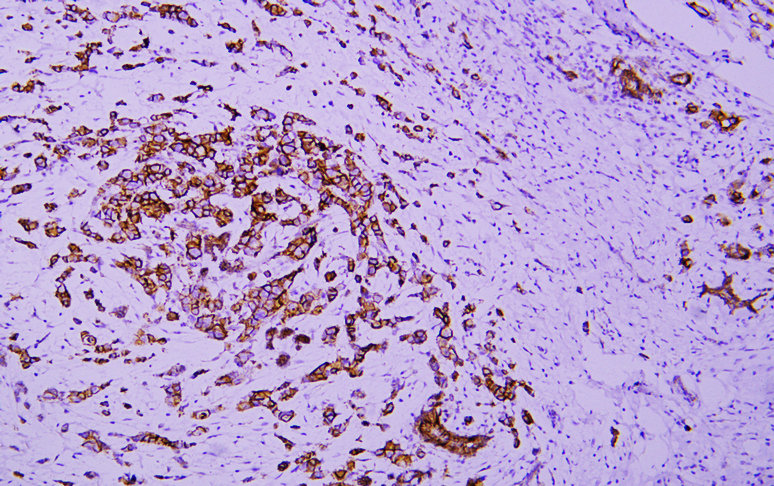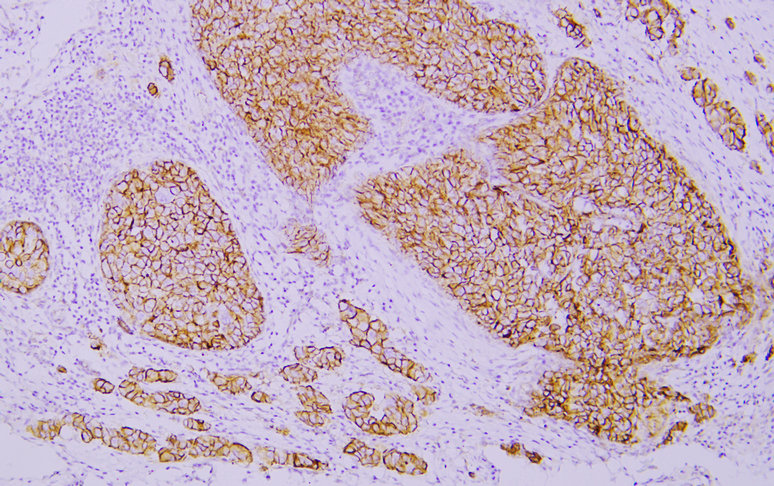p120 catenin (ABT9R) rabbit mAb (Ready to Use)
- Catalog No.:YM7271R
- Applications:IHC
- Reactivity:Human; Mouse; Rat;
- Target:
- p120 Catenin
- Fields:
- >>Rap1 signaling pathway;>>Adherens junction;>>Leukocyte transendothelial migration
- Gene Name:
- CTNND1
- Protein Name:
- p120 catenin
- Human Gene Id:
- 1500
- Human Swiss Prot No:
- O60716
- Immunogen:
- Synthesized peptide derived from human p120 catenin AA range:600-700
- Specificity:
- This antibody detects endogenous levels of p120 Catenin
- Formulation:
- The prediluted ready-to-use antibody is diluted in phosphate buffer saline containing stabilizing protein and 0.05% Proclin 300
- Source:
- Monoclonal, Rabbit IgG1, Kappa
- Dilution:
- Ready to use for IHC
- Purification:
- Recombinant Expression and Affinity purified
- Storage Stability:
- 2°C to 8°C/1 year
- Other Name:
- Cadherin associated Src substRate;Cadherin-associated Src substRate;CAS;Catenin (cadherin associated protein) delta 1;Catenin delta 1;Catenin delta;Catenin delta-1;CTND1_HUMAN;CTNND 1;CTNND;CTNND1;delta 1 Catenin;KIAA0384;p120;P120 CAS;p120 catenin;P120 CTN;p120(cas);p120(ctn);P120CAS;P120CTN
- Molecular Weight(Da):
- 108kD
- Background:
- catenin delta 1(CTNND1) Homo sapiens This gene encodes a member of the Armadillo protein family, which function in adhesion between cells and signal transduction. Multiple translation initiation codons and alternative splicing result in many different isoforms being translated. Not all of the full-length natures of the described transcript variants have been determined. Read-through transcription also exists between this gene and the neighboring upstream thioredoxin-related transmembrane protein 2 (TMX2) gene. [provided by RefSeq, Dec 2010],
- Function:
- alternative products:Experimental confirmation may be lacking for some isoforms,disease:May contribute to cell malignancy. Complete loss of expression was observed in approximately 10% of invasive ductal breast carcinomas investigated.,domain:A possible nuclear localization signal exists in all isoforms where Asp-626--631-Arg are deleted.,function:Binds to and inhibits the transcriptional repressor ZBTB33, which may lead to activation of target genes of the Wnt signaling pathway (By similarity). May associate with and regulate the cell adhesion properties of both C- and E-cadherins. Implicated both in cell transformation by SRC and in ligand-induced receptor signaling through the EGF, PDGF, CSF-1 and ERBB2 receptors. Promotes GLIS2 C-terminal cleavage.,induction:Induced in vascular endothelium by wounding. This effect is potentiated by prior laminar shear stress, which enhances wound clo
- Subcellular Location:
- Cytoplasmic, Membranous
- Expression:
- Expressed in vascular endothelium. Melanocytes and melanoma cells primarily express the long isoform 1A, whereas keratinocytes express shorter isoforms, especially 3A. The shortest isoform 4A, is detected in normal keratinocytes and melanocytes, and generally lost from cells derived from squamous cell carcinomas or melanomas. The C-terminal alternatively spliced exon B is present in the p120ctn transcripts in the colon, intestine and prostate, but lost in several tumor tissues derived from these organs.
- June 19-2018
- WESTERN IMMUNOBLOTTING PROTOCOL
- June 19-2018
- IMMUNOHISTOCHEMISTRY-PARAFFIN PROTOCOL
- June 19-2018
- IMMUNOFLUORESCENCE PROTOCOL
- September 08-2020
- FLOW-CYTOMEYRT-PROTOCOL
- May 20-2022
- Cell-Based ELISA│解您多样本WB检测之困扰
- July 13-2018
- CELL-BASED-ELISA-PROTOCOL-FOR-ACETYL-PROTEIN
- July 13-2018
- CELL-BASED-ELISA-PROTOCOL-FOR-PHOSPHO-PROTEIN
- July 13-2018
- Antibody-FAQs
- Products Images

- Immunohistochemical analysis of paraffin-embedded human Breast carcinoma-1. 1, Antibody was incubated at 4° overnight. 2, TRIS-EDTA of pH9.0 was used for antigen retrieval. 3,Secondary antibody was diluted at 1:200(room temperature, 30min).

- Immunohistochemical analysis of paraffin-embedded human Breast carcinoma. 1, Antibody was incubated at 4° overnight. 2, TRIS-EDTA of pH9.0 was used for antigen retrieval. 3,Secondary antibody was diluted at 1:200(room temperature, 30min).



